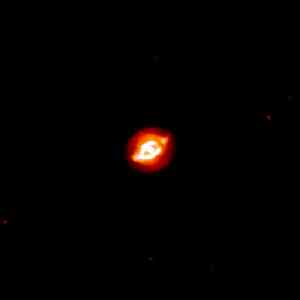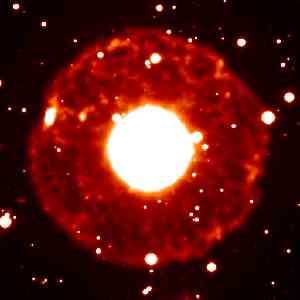AIP astronomy picture of the month
(previous pictures of the month)
Mass loss during the final stages of stellar evolution
 |
 |
|
View of NGC 6826 at different exposure times; both images cover the same field of view. (Credit: R. Corradi, ING & M. Steffen, AIP) Most of the stars, including the Sun, go through the Planetary Nebula (PN) phase at the end of their evolution. This short-lived but spectacular phenomenon marks the transition from a Red Giant star (about 100 times the present solar size) to a White Dwarf (1/100 the present size of the Sun). The very existence of Planetary Nebulae is a direct proof that stars which do not explode as supernovae loose a significant fraction of their mass at the end their active nuclear life, enriching the interstellar medium by freshly synthesized elements before they begin to cool toward the white dwarf cemetery. NGC 6826 is a well-studied example of a bright double-shell PN of elliptical shape. The images were taken with the wide field camera at the prime focus of the 2.5m Isaac Newton Telescope of the ING at La Palma in October 2001, using a 100 Angstrom wide filter centered on H_alpha (including the [NII] doublet). An exposure time of 3 min is sufficient to reveal the typical double-shell structure of the PN (left image). A much longer exposure time is necessary to detect the faint extended halo surrounding the PN proper. The right image is the result of 2.5 hours of integration (15 x 10 min). The long exposure time together with the short focal ratio of the prime focus of the INT makes this image clearly the deepest one ever obtained of NGC 6826. The highly spherical halo represents material expelled by the red giant wind before the formation of the PN. Extensive hydrodynamical model calculations have been performed at the AIP in order to understand the formation and evolution of Planetary Nebulae and their haloes. Based on recent simulations, we could derive the mass loss history during the end of the previous AGB phase of evolution from the observed density structure of the halo of NGC 6826 (AGB wind paleontology). The results were presented at IAU Symposium No. 209 in Canberra (Australia) in November 2001. Details may be found in the conference proceedings (Halo Poster, Halo Paper, Halo Review, PN Review). | |